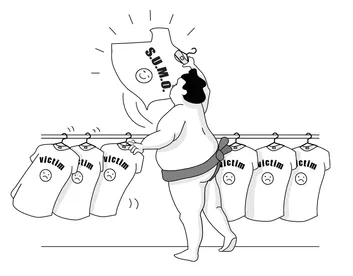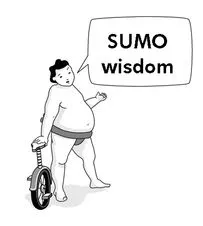![]()
Chapter 1
Change Your T-shirt
Let me start by asking you the same two questions I ask people when I am running a workshop or speaking at a conference. Firstly, ‘Do you drive a car?’ And secondly, ‘Did you get yourself dressed this morning?’ If you answered yes to either question you’ll relate to the following fact - much of what we do in life we do without consciously thinking about it. Ever had the experience of taking a familiar car journey and suddenly finding yourself at your destination and wondering ‘How did I get here?’ Or find yourself driving on the motorway and asking yourself ‘What happened to those last ten miles?’ When you got dressed this morning, did you consciously decide in what order to get dressed? Did you weigh up the pros and cons of which shoe to put on first? If not, then you probably identify with the concept I call ‘auto-pilot syndrome’.
We are about to go on a journey. Except on this journey I want you to be very conscious of where you are going and how you get there. To do so, your first step in the SUMO process is to ensure that you take time out, off auto-pilot, and honestly assess how you have been living your life so far. To help you do this, here are three questions to consider.
1. Which person has the biggest influence on your life?
2. Who deserves the most credit for where you currently find yourself in life?
3. Whose advice and opinions do you tend to always act upon?
Let me share with you my answers. (Although I have to confess they would not always have been my response.)
1. Which person has the biggest influence on your life? I do.
2. Who deserves the most credit for where you currently find yourself in life? I do.
3. Whose advice and opinions do you tend to always act upon? My own.
How do they match yours? I admit there are many people who have influenced my life and who deserve credit for how they have helped me. And I have listened to the advice and opinions of others; but ultimately, the biggest single factor that determines where you and I currently find ourselves in life is ‘you’.
If you want to know who is most responsible for where you are in life, take a look in the mirror.
Here is the challenge. We live in a climate and culture where this outlook is not always encouraged. How comfortable do you feel about standing up and saying ‘I take full responsibility for my life?’ Let’s explore why many people would not only feel uncomfortable saying that statement, they would also disagree with it. I call it the BSE crisis.
The great BSE crisis
I meet individuals who believe that their current circumstances in life have:
1. Nothing to do with the previous decisions they have made.
2. Nothing to do with the actions they have taken.
3. Nothing to do with the attitudes they have adopted.
Apart from that, they take full responsibility for everything.
If life is not as they would want it, they can quickly play their BSE card - Blame Someone Else. ‘I mean, what can I do?’ they ask, ‘It’s not my fault. Someone else is to blame.’
Not only do they carry their own personal BSE card, they also tend to wear a particular T-shirt. Confused? Let me explain.
Imagine for a moment that how you felt or what you believed about yourself was written on your T-shirt. Some T-shirts may have the phrase ‘I am confident’ or ‘I feel good about myself’; whilst others may have ‘I lack self-belief’ or ‘I don’t like people’ (I have met a few of those). BSE card carriers though, wear one with the message - ‘Victim ’. Wearers of this T-shirt tend to think, say and believe the following:
‘This is my life and I must grin and bear it.’
‘It’s not my fault.’
‘Life is not fair.’
‘I’ve never been lucky.’
‘I blame the government/my parents/the traffic /my boss/my teachers/my kids.’
‘I cannot really change or influence my situation.’
‘I’m not capable.’
‘I’m not confident.’
‘I’m not good enough.’
When a group of victim T-shirt weares get togetther they hold wearers get together they hold a ‘blame storming’ session.
The personal stuff
Have I ever worn the T-shirt? You bet. I failed my Geography ‘A’ Level and blamed the teachers, until someone pointed out that not every pupil in the class had failed.
In my early days of business I blamed the economy for my lack of success. Things were not buoyant when I began, but it was easier to use the excuse of outside factors than to take a look at my own actions and decisions.
More recently I failed to secure a place as a main speaker at a large sales conference. I had put a great deal of time and effort into persuading the organizers that I was the ideal speaker for this high profile event. When the ‘no thanks’ news came through I was gutted, particularly when I found out who had been chosen instead of me. I muttered to myself ‘That’s not fair … I’m a far better speaker than him’. It took several hours before I realized that I was wearing the Victim T-shirt.
So why wear the T-shirt in the first place?
Here are four reasons why we might be tempted to wear the Victim T-shirt:
Reason 1
You feel you have no other choice. ‘That’s just the way it is, there’s nothing I can do’ is the mantra of people who play the victim role. You can adopt a fatalistic approach to life and to the inevitability of being the victim.
Reason 2
Low self-esteem and poor self-image. Either of these factors can distort your view of how you see a situation. Your esteem and self-image can be affected by ‘life events’ and you are more vulnerable to seeing them damaged when you have experienced a major change such as a divorce, redundancy or an illness. Such events can knock your self-confidence, which in turn affects how you think and feel about yourself.
Reason 3
It’s become a habit. Some people have been putting on the T-shirt so regularly, they now wear it without even being conscious of the fact. Their wardrobe consists of a whole range of styles and colours of Victim T-shirts. One to suit any occasion.
Reason 4
People actually enjoy wearing it. My research reveals that wearing the Victim T-shirt can bring people many perceived benefits:
• People feel sorry for you and give you more attention.
• It can increase your own feeling of self-importance.
• It is a good excuse for not being able to achieve other things (I would have been able to achieve X if only Y had been more supportive).
• Blaming others frees you from the responsibility of taking charge of your own life.
Points to ponder
It’s not easy to admit that you have worn the T-shirt. Maybe you haven’t; but if you have, what has been your reason? Can you identify people you know who wear the T-shirt? What in your view motivates them to wear one?
The personal stuff
When I became ill with chronic fatigue syndrome I went from a high-flying management position to invalidity benefit. Life did not seem very fair and for a while I wore the Victim T-shirt. I used to queue up to collect my benefit on the same day pensioners got theirs. I was twenty-four years old. Talking about the weather and the price of baked beans became part of my everyday conversation and did little to make me feel better about myself. I eventually decided that I needed to excuse myself from the pity party and focus on what was still good about my life. I was surprised how much I found. For instance, I realized what an incredible wife I had and how fortunate I was to have so many supportive friends. We still had our own home and I found time to join a creative writing group. We even managed the occasional weekend away, courtesy of someone else’s generosity.
People are not alwa...



